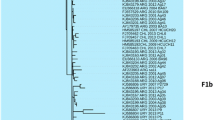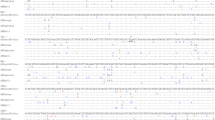Summary
We report here the nucleotide sequences of the core region of HCV isolates from Egyptian and Yemeni patients and the method for classifying these HCV isolates by phylogenetic analysis. Sequence comparison suggested that the genotypes of these isolates were the same. Preliminary phylogenetic analysis of the HCV core region indicated that the genotypes of both isolates were 1c. However, an additional phylogenetic tree of the HCV core region constructed using a greater number of HCV isolates than that used in the preliminary analysis and on the basis of alignment of nucleotide sequences in an appropriate length indicated that the genotypes of these isolates were 4 and not 1c. For a more detailed analysis, the nucleotide sequences of the HCV E1 region as well as the core region for the same Yemeni patient were determined. A phylogenetic tree of the E1 region confirmed that the genotype of the HCV isolate from the Yemeni patient was 4. These data indicate that even when classifying HCV isolates using phylogenetic analysis, the misclassification would occur if care is not taken regarding the number and sequence lengths of the isolates included in the analysis.
Similar content being viewed by others
References
Alter HJ, Purcell RH, Shih JW, Molepolder JC, Houghton M, Choo QL, Kuo G (1989) Detection of antibody to hepatitis C virus in prospectively followed transfusion recipients with acute and chronic non-A, and non-B hepatitis. N Engl J Med 321: 1494–1500
Bukh J, Purcell RH, Miller RH (1993) A least 12 genotypes of hepatitis C virus predicted by sequence analysis of the putative E1 gene of isolates collected wordwide. Proc Natl Acad Sci USA 90: 8234–8238
Bukh J, Purcell RH, Miller RH (1994) Sequence analysis of the core gene of 14 hepatitis C virus genotypes. Proc Natl Acad Sci USA 91: 8239–8243
Cha TA, Beall E, Irvine B, Kolberg J, Chien D, Kuo G, Urdea S (1992) At least five related, but distinct, hepatitis C viral genotypes exist. Proc Natl Acad Sci USA 89: 7144–7148
Chan SW, Simmonds P, McOmish F, Yap PL, Mitchell R, Dow B, Follett E (1991) Serological responses to infection with three different types of hepatitis C virus. Lancet 338: 1391
Chan SW, McOmish F, Holmes EC, Peutherer JF, Follett E, Yap PL, Simmonds P (1992) Analysis of a new hepatitis C virus type and its phylogenetic relationship to existing variants. J Gen Virol 73: 1131–1141
Chayama K, Tsubota A, Arase Y, Koida I, Ikeda K, Matsumoto T, Kobayashi M, Iwasaki S, Koyama S, Morinaga T, Kumada H (1993) Genotypic subtyping of hepatitis C virus. J Gastroenterol Hepatol 8: 150–156
Choo QL, Kuo G, Weiner AJ, Overby LR, Bradley DW, Houghton M (1989) Isolation of a cDNA clone derived from a blood-borne non-A, non-B viral hepatitis genome. Science 244: 359–362
Choo QL, Weiner AJ, Overby LR, Kyo G, /Houghton M, Bradley DW (1990) Hepatitis C virus: the major causative agent of viral non-A, non-B hepatitis. Br Med Bull 46: 423–441
Choo QI, Richman KH, Han JH, Berger K, Lee C, Dong C, Gallegos C, Coit D, Medina Selby R, Barr PJ, Weiner AJ, Bradley DW, Kuo G, Houghton M (1991) Genetic organization and diversity of the hepatitis C virus. Proc Natl Acad Sci USA 88: 2451–2455
Dusheiko G, Schmilovitz-Weiss H, Brown D, McOmish F, Yap PL, Sherlock S, McIntyre N, Simmonds P (1993) Hepatitis C virus genotypes: an investigation of type-specific differences in geographic origin and disease. Hepatology 19: 13–18
Enomoto N, Takada A, Nakao T, Date T (1990) There are two major types of hepatitis C virus in Japan. Biochem Biophys Res Commun 170: 1021–1025
Gojobori T, Ishii K, Nei M (1982) Estimation of average number of nucleotide substitutions when the rate of substitution varies with nucleotide. J Mol Evol 28: 414–423
Ina Y, Mizokami M, Ohba K, Gojobori T (1994) Reduction of synonymous substitutions in the core protein gene of hepatitis C virus. J Mol Evol 38: 50–56
Kato N, Hijikata M, Ootsuyama Y, Nakagawa M, Ohkoshi S, Sugiura T, Shimotohno K (1990) Molecular cloning of the human hepatitis C virus genome from Japanese patients with non-A, non-B hepatitis. Proc Natl Acad Sci USA 87: 9524–9528
Kuo G, Choo QL, Alter HJ, Gitnick GL, Redeker AG, Purcell RH, Miyamura T, Dienstag JL, Alter MJ, Stevence CE, Tegtmeier GE, Bonino F, Colombo M, Lee WS, Kuo C, Berger K, Shuster JR, Overby LR, Bradley DW, Houghton M (1989) An assay for circulating antibodies to a major etiologic virus of human non-A, non-B hepatitis. Science 244: 362–364
McOmish F, Cha SW, Dow BC, Gillon J, Frame WD, Crawford RJ, Yap PL, Follett EAC, Simmonds P (1993) Detection of three types of hepatitis C virus in blood donors: investigation of type-specific differences in serologic reactivity and rate of alanine aminotransferase abnormalities. Transfusion 33: 7–13
Mizokami M, Ohba K (1993) Molecular classification of hepatitis C virus. Gastroenterol Jpn 28: 42–44
Mori S, Kato N, Yagyu A, Tanaka T, Ikeda Y, Petchclai B, Chiewslip P (1992) A new type of hepatitis C virus in patients in Thailand. Biochem Biophys Res Commun 183: 334–342
Mosley JW, Aach RD, Hollinger B, Stevens, CE, Barbosa LH, Nemo GJ, Holland PV, Bancroft WH, Kuo G (1990) Non-A, non-B hepatitis and antibody to hepatitis C virus. JAMA 263: 77–78
Nakao T, Enomoto N, Takada N, Date T (1991) Typing of hepatitis C virus genomes by restriction fragment length polymorphism. J Gen Virol 72: 2105–2112
Nei M, Gojobori T (1986) Simple methods for estimating the numbers of synonymous and nonsynonymous nucleotide substitutions. Mol Biol Evol 3: 418–426
Ohno T, Mizokami M, Tibbs CJ, Ohba K, Suzuki K, Wu RR, Nouri-Aria KT, Williams R (1994) New genotype of hepatitis C virus in South Africa. J Med Virol 42: 409–413
Ohno T, Mizokami M, Tibbs CJ, Nouri-Aria KT, Wu RR, Ohba K, Orito E, Suzuki K, Mizoguchi N, Nakano T, Yano M, Kiyosawa K, Williams R (1994) The nucleotide-sequence of the core region of HCV in Pakistan and Bangladesh and the geographical characterization of HCV in South Asia. J Med Virol 44: 362–368
Okada S, Akahane Y, Suzuki H, Okamoto H, Mishiro S (1992) The degree of variability in the amino terminal region of the E2/NS1 protein of hepatitis C virus correlates with responsiveness to interferon therapy in viremic patients. Hepatology 16: 619–624
Okamoto H, Okada S, Sugiyama Y, Kurai K, Iizuka H, Machida A, Miyamura Y, Mayumi M (1991) Nucleotide sequence of the genomic RNA of hepatitis C virus isolated from a human carrier: comparison with reported isolates for conserved and divergent regions. J Gen Virol 72: 2697–2704
Okamoto H, Kurai K, Okada S, Yamamoto K, Iizuka H, Tanaka T, Fukuda S, Tsuda F, Mishiro S (1992) Full-length sequence of a hepatitis C virus genome having poor homology to reported isolates: comparative study of four distinct genotypes. Virology 188: 331–341
Okamoto H, Sugiyama Y, Okada S, Kurai K, Akahane Y, Sugai Y, Tanaka T, Sato K, Tsuda F, Miyamura Y, Mayumi M (1992) Typing hepatitis C virus by polymerase chain reaction with type-specific primers: application to clinical surveys and tracing infectious sources. J Gen Virol 73: 673–679
Saito I, Miyamura T, Ohbayashi A, Harada H, Katayama T, Kikuchi S, Watanabe Y, Koi S, Onji M, Ohta Y, Choo QL, Houghton M, KUo G (1990): Hepatitis C virus infection is associated with the development of hepatocellular carcinoma. Proc Natl Acad Sci USA 87: 6547–6549
Saitou N, Nei M (1987) The neighbor-joining method: a new method for reconstructing phylogenetic trees. Mol Biol Evol 4: 406–425
Simmonds P, Holmels EC, Cha TA, Chan SW, McOmish F, Irvine B, Beall E, Yap PL, Kolberg J, Urdea MS (1993) Classification of hepatitis C virus into six major genotypes and a series of subtypes by phylogenetic tree analysis. J Gen Virol 74: 2391–2399
Simmonds P, Alberti A, Alter HJ, Bonino F, Bradley DW, Brechot C, Brouwer JT, Chan SW, Chayama K, Chen DS, Choo QL, Colombo M, Cuypers TM, Date T, Dusheiko GM, Esteban JI, Fay O, Hadziyannis SJ, Han J, Hatzakis A, Holmes EC, Hotta H, Houghton M, Irvine B, Kohara M, Kolberg JA, Kuo G, Lau JYN, Lelie PN, Martens G, McOmish F, Miyamura T, Mizokami M, Nomoto A, prince AM, Reesink HW, Rice C, Roggendorf M, Schalm SW, Shikata T, Shimotohno K, Stuyber L, Trepo C, Weiner A, Yap PL, Urdea M (1994) A proposed system for the nomenclature of hepatitis C viral genotypes. Hepatology 19: 1321–1324
Takada N, Takase S, Takada A, Date T (1993) Differences in the hepatitis C virus genotypes in different countries. J Hepatol 17: 277–283
Yoshioka K, Kakumu S, Wakita T, Ishikawa T, Itoh Y, Takayanagi M, Higashi Y, Shibata M, Morishima T (1992) Detection of hepatitis C virus by polymerase chain reaction and response to interferon α therapy: relationship to genotypes of hepatitis C virus. Hepatology 16: 293–299
Author information
Authors and Affiliations
Rights and permissions
About this article
Cite this article
Ohno, T., Mizokami, M., Saleh, M.G. et al. Usefulness and limitation of phylogenetic analysis for hepatitis C virus core region: application to isolates from Egyptian and Yemeni patients. Archives of Virology 141, 1101–1113 (1996). https://doi.org/10.1007/BF01718613
Received:
Accepted:
Issue Date:
DOI: https://doi.org/10.1007/BF01718613




